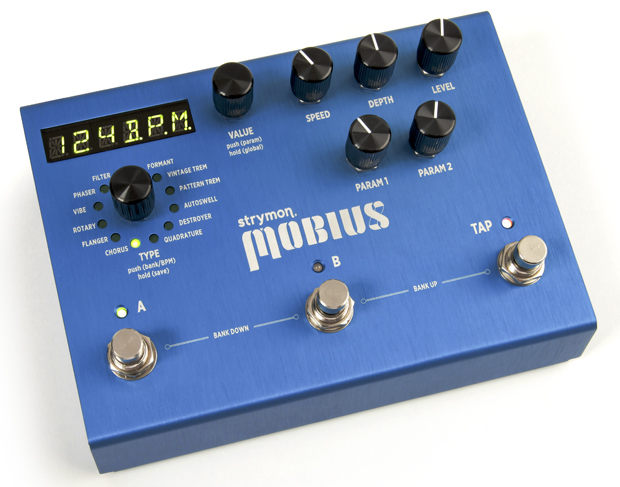Review: Strymon Mobius Modulation Effect Pedal

Over the past 20 years, many companies have developed products that promise to accurately reproduce classic analog effects, but Strymon has turned that pursuit into both a science and an art.
Perhaps the best testimony to the quality of Strymon’s effect pedals is the near-ubiquitous presence of their products in the pedal boards and racks of countless pros, including some of the most conservative analog-purist guitarists.
The Mobius is Strymon’s second “large-format” pedal, sharing a similar configuration to the company’s popular TimeLine delay unit, but the Mobius specializes in various modulation effects, including chorus, phaser, flanger, rotary, vibe, tremolo and much more.
With true stereo inputs and outputs, MIDI in and out, and memory for 200 presets, the Strymon Mobius boasts the power of a professional-quality rack processor while offering the convenience and immediacy of a stomp box.
Features
The heart of the Mobius is a powerful SHARC DSP that provides extremely detailed, lightning-fast processing and pro-quality, low-noise performance. The pedal has 12 individual effects—chorus, flanger, rotary, vibe, phaser, filter, formant, vintage trem, pattern trem, autoswell, destroyer and quadrature—that are selected with a rotary switch. The pedal’s 200 presets can be selected with the value control and A and B footswitches or via MIDI using program-change commands. In addition to the value control, which selects various parameters when pushed down, users can adjust parameters with the speed, depth, level, and assignable parameter 1 and parameter 2 control knobs. The front panel also includes a dedicated tap tempo footswitch for manually adjusting the effect’s speed.
The rear panel includes 1/4-inch left and right input and output jacks for true stereo operation, an 1/4-inch expression input for adjusting assignable parameters with an expression pedal, a pre/post switch that lets you use the inputs and outputs to place the Mobius at different locations in a mono pedal board signal chain, and individual MIDI in and out jacks. The pedal operates via an included standard nine-volt DC adapter and requires a minimum current draw of 300mA.
Internal settings allow users to select true or analog-buffered bypass, tap-tempo subdivisions (which are independently assignable to each preset), an optional global tap-tempo mode and various menu-driven parameters for each effect. The large six-character LED display shows preset, parameter, or bpm settings, depending on how the pedal is being used.
Performance
With 24-bit 96kHz A/D and D/A converters, 32-bit floating point processing and a dead-quiet 110dB signal-to-noise ratio, the specifications of the Mobius pedal are simply stunning. Many digital processors sound sterile and lifeless, but the Mobius is rich, warm and detailed, with all of the expressiveness and character of classic analog effects and none of the noisy by-products. The chorus and flanging produce thick, luxuriant textures when you want them, but they can also sound razor-sharp and brilliant if you prefer. The vibe effect is similarly lush and sounds as good as, if not better than, many stand-alone boutique-vibe pedals that cost as much or more than the Mobius.
In addition to classic effects, the Mobius pedal offers an impressive assortment of unique and unusual ones. The formant filter produces voice-like vowel sounds, while the pattern trem delivers tremolo that pulsates in various rhythmic patterns instead of the usual steady intervals. Destroyer is an amazing low-fi effect that can make a guitar sound like a scratchy old 78-rpm record, a telephone transmission, a video game and more. Quadrature offers a selection of amplitude, frequency and single-side-band modulation effects that range from metallic ring-modulator dissonance to synth-like pulsations. The Mobius’s range of effects is impressive, running the gamut from Sixties tremolo to present-day experimental flavors.
Strymon designed the Mobius to perform equally well in the studio or onstage. When new presets are selected, the new effect is engaged instantaneously, with no latency delays or awkward moments of silence. Parameters controlled via the expression input change values smoothly and seamlessly, with no digital “zipper” noise. While the Mobius is as powerful as a dedicated rack processor, it’s very easy to use and program. Even old-school analog luddites will find it satisfyingly simple to use in their rigs.
Cheat Sheet
Street Price $449
Manufacturer Strymon, strymon.net
A DSP-based effect offering 12 stunning modulation effects spanning five decades, including Sixties tremolo, Seventies chorus and flanging and modern lo-fi sounds.
The pedal stores 200 presets, which are accessible via A and B footswitches and a Value control or using MIDI program change commands.
The pair of inputs and outputs feature a switch that allows users to configure them for true stereo operation or to place the Mobius in different locations in a mono signal chain.
The expression pedal input is individually assignable per preset to any parameter or combination of parameters.
The Bottom Line
Offering a complete collection of 12 dazzling modulation effects, the Strymon Mobius is an exceptional value for guitarists who want world-class, expressive tones and textures.
Get The Pick Newsletter
All the latest guitar news, interviews, lessons, reviews, deals and more, direct to your inbox!
Chris is the co-author of Eruption - Conversations with Eddie Van Halen. He is a 40-year music industry veteran who started at Boardwalk Entertainment (Joan Jett, Night Ranger) and Roland US before becoming a guitar journalist in 1991. He has interviewed more than 600 artists, written more than 1,400 product reviews and contributed to Jeff Beck’s Beck 01: Hot Rods and Rock & Roll and Eric Clapton’s Six String Stories.
“Sonically excellent… we found that it could be a viable substitute for our vintage 1970s pedals”: Hamstead x That Pedal Show Redwing Analogue Stereo Modulator review
“The original Jordan Boss Tone was probably used by four out of five garage bands in the late ’60s”: Unpacking the gnarly magic of the Jordan Boss Tone – an actual guitar plug-in that delivers Dan Auerbach-approved fuzz

